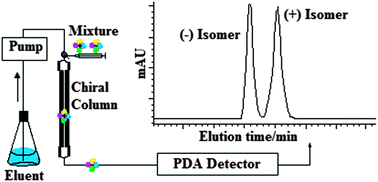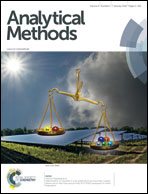Enantiomeric separation of sitagliptin by a validated chiral liquid chromatographic method
Abstract
An enantioselective reversed phase high performance liquid chromatographic method was developed and validated. The enantiomers of sitagliptin were resolved on a Chiralcel OD-RH (150 mm × 4.6 mm, 5 μm) column using a mobile phase system containing 3 M potassium di-hydrogen phosphate buffer (pH 4.0)–methanol–acetonitrile (60 : 30 : 10, v/v/v). The resolution between the enantiomers was not less than 3.0. The pH value of buffer solution in the mobile phase played a key role in enhancing chromatographic efficiency and resolution between the enantiomers. The developed method was validated according to ICH guidelines. The calibration curve was found to be linear over the concentration range of 30–300 ng mL−1 (r2 = 0.9996). The limit of detection and limit of quantification of the (S)-enantiomer were found to be 8 and 30 ng mL−1, respectively, for 20 μL injection volume. The percentage recovery of the (S)-enantiomer ranged from 99.06 to 100.2 in bulk drug samples of sitagliptin. The sample solution and mobile phase were found to be stable at least for 48 h. The final optimized method was successfully applied to separate the (S)-enantiomer from sitagliptin and was proved to be reproducible, accurate and robust for the quantitative determination of the (S)-enantiomer in bulk drugs.


 Please wait while we load your content...
Please wait while we load your content...